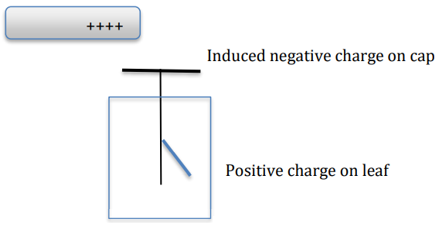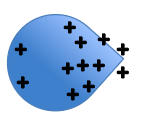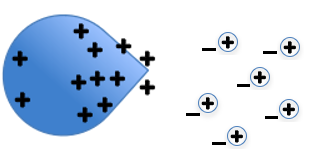Question
- Leaving Certificate Physics (Higher) 2021: Section B Q12
- Back to the question >
Answer
The Wimshurst machine is an electrostatic generator for generating high voltages. It uses the principles of charging by induction and point discharge to store energy in two large capacitors. Wimshurst machines provided a source of high voltage for early X‐ray tubes.
(i) Describe a laboratory experiment to demonstrate charging by induction.
To demonstrate charging by induction:

- Take an uncharged electroscope, where the leaves are flat (indicating the absence of a charge).
- Take a plastic rod and rub it against your hair. This should build up a charge by contact.
- Hold the charged end of the rod near to the cap of the electroscope.
- The leaf of the electroscope should rise, indicating that it now carries a charge, which has been added to the electroscope without contact, and therefore, via induction.
- This charge can be made permanent by briefly touching (and therefore, earthing) the cap before removing the rod.

(ii) Explain how point discharge occurs
The point effect is when charge tends to build up on the pointed ends of any irregular shape, as shown below.

A large build-up of charge in a small place tends to ionise the surrounding air. If the point carries a negative charge, the free electrons created in the air will then tend to move to the centre of charge — the point. The two charges will neutralise each other.
Any remaining charge on the object will then rearrange itself so that it moves towards the point, and the process will repeat until the object is discharged. The process is often accelerated by the ionisation of the air itself.

The plates of a parallel plate capacitor of capacitance 3.2 pF have a common area of 20cm2 and are 15mm apart.
(iii) Calculate the relative permittivity of the capacitor’s dielectric.
Relative permittivity is calculated using the following formula:

To compete that calculation, we must first find the actual permittivity, ε.
Using

we can say that:

Subbing into the original equation:

(iv) What would be the effect on the capacitance if the distance between the plates was doubled?
Using  we can see that the capacitance is inversely proportional to the distance between the plates.
we can see that the capacitance is inversely proportional to the distance between the plates.
Therefore, doubling that distance would halve the value of the capacitance.
(v) Three such capacitors are connected in parallel. Explain why the effective capacitance of this combination is 9.6 pF.
Capacitance follows the formula, C
As the charge, Q, on each plate will be equal, the total charge will be 3Q. The voltage across the arrangement will be constant, V.
This means that the total capacitance of the arrangement, C, will be:

(vi) Draw the electric field pattern in a charged parallel plate capacitor.

A voltage of 20 kV is applied between the cathode and the anode in an X‐ray tube.
(vii) Why is the cathode of an X‐ray tube hot?
The cathode is hot due to the presence of a low voltage heater beside it.
This is done to ensure that thermionic emission will occur, which is the emission of electrons from the surface of a hot metal. This is how the beam of electrons is created that ultimately leads to the release of the X-rays at the anode.
(viii) Calculate the maximum speed of an electron as it moves between the cathode and the anode.
The maximum energy of the electrons is:
𝐸 = 𝑞𝑉 = (1.602 × 10 −19)(20,000) = 3.204 × 10 −15 J
𝐸𝑘 = ½ 𝑚𝑣2
𝑣2= 7.03 × 10 −15
And the maximum velocity is: 𝑣 = 8.39 × 10 7 𝑚𝑠−1
(ix) What happens to the energy of the electrons when they hit the anode?
Most of this energy is converted into heat in the anode, which is dissipated by a temperature control system. A small percentage is absorbed by the atoms in the anode and released as X-rays.
